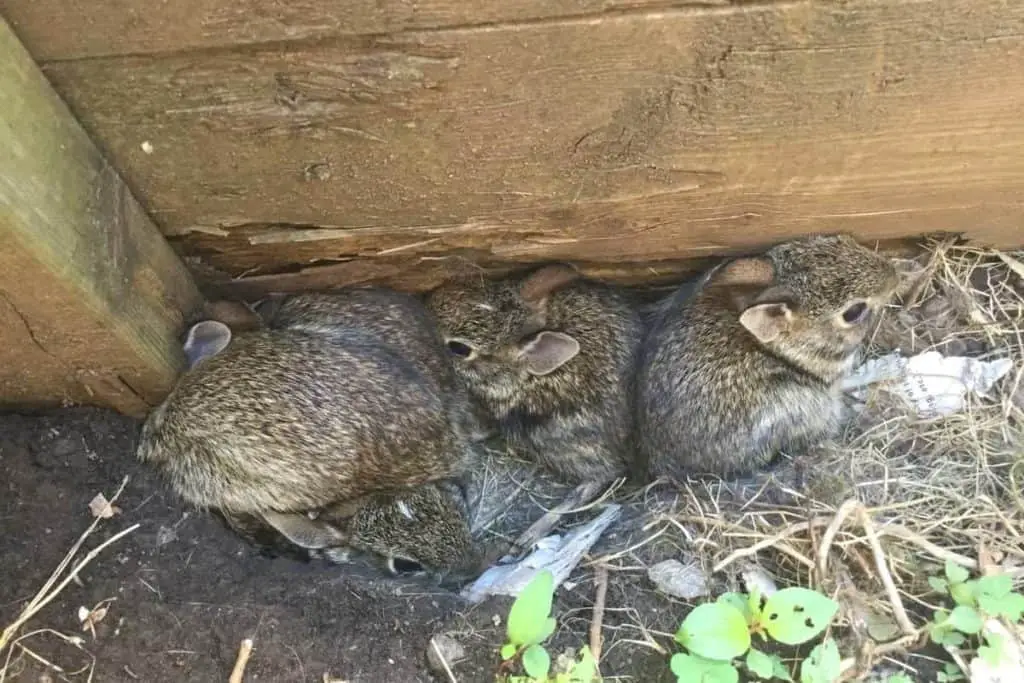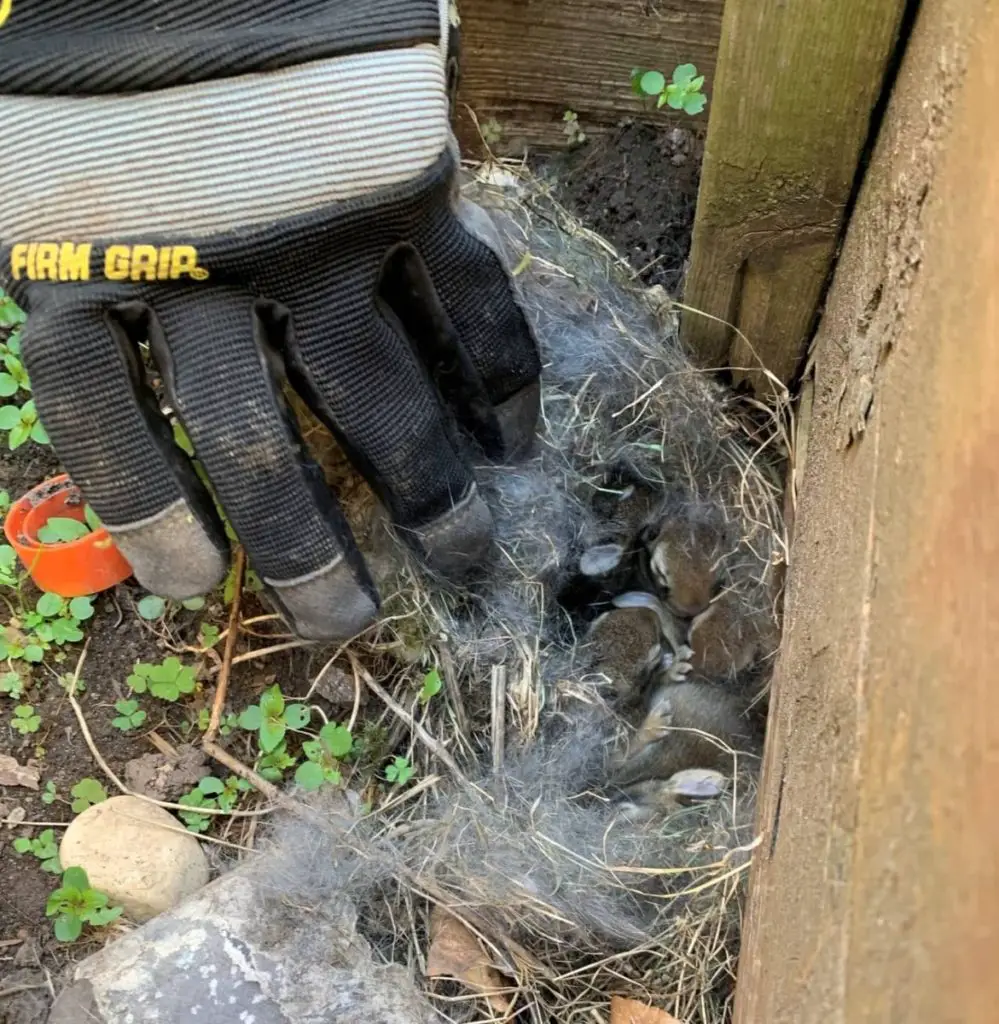
So you’ve found a nest of rabbits in your backyard and are wondering what to do with them? We faced exactly the same dilemma! I’ll tell our story with backyard bunnies a little below but the good news is that dealing with a bunny nest in your yard is easy. What should you do if you find a nest of bunnies in your yard?
If the nest is healthy, leave them alone. If the nest is disturbed and there is no sign of health issues, put the nest back together as best you can and leave it be. If there look to be obvious injuries, contact your city’s animal control department or a wildlife rehabilitator.
Ok – let’s start with our story.
Our Bunny Story
I’ve said in other posts that we’ve lived in our house for more than a decade, and the backyard hasn’t been the focus of our efforts… until now. The house we bought was something of a fixer-upper with lots of original features and decor in our 1986 home.
We had planned to replace our original fences early this year but then the pandemic hit and our plans got put on hold – and we couldn’t be happier! Our side fence has two old planter boxes and a mama bunny decided that one of them would make a great playpen.
We came out one day to see a weird combination of trash and fur in the small planter. A little bit of research told us that this was a bunny nest and we all got a little excited.
You will notice how full of weeds and greenery that box is – since we had planned to rip it out this year there was no need to do anything with it. It’s also on the far side of the house from the door, so we barely go back there except to get to the shed.
The nest was moving a little so we knew there was something inside it and decided to do a little more research. It turns out that a mama cottontail won’t reject her nest after it’s been touched – only if it’s been moved. In fact, if you find a nest that has been disturbed by an animal and there are still remaining kittens (baby bunnies are called kittens) you can try to rebuild the nest as much as possible and replace the kits. They won’t abandon it because someone touched the nest, but they will if it moves even a foot or two away – so if you do find a disturbed nest try and put it back together exactly where you found it.
A cottontail bunny creates a nest by digging out a hole and layering the bottom with grass and fur torn from her body. When she births the kittens they are covered over with more grass and fur and other things (in our case there was some garbage eventually as well) to hide the kittens. They don’t smell much so secrecy and camouflage is their first line of defense. For more information on the nests, check out the Toronto Wildlife Centre’s page on bunny nest.
Now, we know that you’re not supposed to disturb a nest if you can avoid it, and that’s always good advice. But this opportunity was too good to pass up. Given that, we very carefully moved the top layer of the nest to give ourselves a look to make sure that it was truly a bunny nest. And it surely was – and they are super cute.

We covered everything back up securely and left the nest in peace. During the next week or so we kept seeing the mama bunny in the yard – watching for a time when it would be safe to visit her kits.

One thing you can do to help a mama bunny with kits it to hold off pulling dandelions and cutting the grass for a few weeks, as dandelions are some of their favorite foods.
Now Eastern Cottontail Rabbits are only in the nest for about three weeks from the time they are born until the time that they’re ready to be out on their own. You can tell when they’re ready when they are fully furred, their eyes are opened, and their ears stand up straight. About two week after we found the nest we came out one day and the top of the nest was gone – and there were 6 little rabbits ready to get to it! I set up a time lapse on them for a couple of days and got this on the first day.
We knew that we didn’t have long, but on the second day there were only three bunnies left in the nest. I put up the time lapse camera anyway and we caught some good action. This video was edited a bit to reduce the times with no movement.
And that was the end of our bunny adventure for the summer. If you watch the videos you see why there’s no greenery left in that box by the time the bunnies leave! We know they haven’t traveled far, as we’re seeing the kits from time to time around the yard, but they’ve escaped their pen and are on to their next adventure too.
If the Nest is Disturbed
Fortunately, we never experienced this (and there was good cover for this nest) but sometime animals (cats, dog, raccoons, skunks, etc) will get a a bunny nest and cause issues. If you find a bunny nest that has been disturbed take a quick look at the kittens to see if there are any obvious injuries (blood is a good indicator). If there aren’t you can go ahead and put the nest back together and set up a string test (Toronto Wildlife Centre) to see if the mama will start visiting again.
If there are signs of trouble (or you know the encounter was with a cat) it’s the right time to contact animal control or a rehabilitator. Raising wild bunnies is not a simple thing, so you’ll want to get the experts involved.
Some Things to Remember About Bunny Nests
- If you find a bunny nest – don’t move it. Even it it seems to be in a bad place moving the nest even a foot or two could cause a mama to abandon it
- If you find a disturbed bunny nest you can try to put it back together. Put the dried grass and fur on the bottom, replace the kits, and cover with remaining materials and more dried grass if required. Check out the Toronto Wildlife Centre’s for more info and how to do a string test to see if the mama has come back.
- Eastern Cottontail Rabbits (the rabbits that live in the wild near us) stay in the nest about 3 weeks, and are ready to go when they are fully furred, have open eyes, and ears that stand up on end. They will also be about the size of a chipmunk (and so cute you’ll want to grab them and take them home – don’t do that!)
- Touching a rabbit won’t usually cause a mama to abandon it, but it’s probably better to avoid it if you can. If you find bunnies outside the nest and they seem to be good to go (see #3) – they don’t need to be put back. If their eyes aren’t open or they’re not fully furred, they may need a little ride and to be recovered if you can find the nest.
- Wild rabbits don’t do very well in captivity. It’s better to let nature take her course. If you want a bunny, visit the pet store.
- If you find a bunny nest where the bunnies are obviously injured, contact your city’s animal control or a wildlife rehabilitator.
There is a reason that you hear the phrase “breed like rabbits” – so we’ll see if this mama ends up dropping a second batch for us – and if she ends up using the same spot. But until then – go out and enjoy your backyard!

